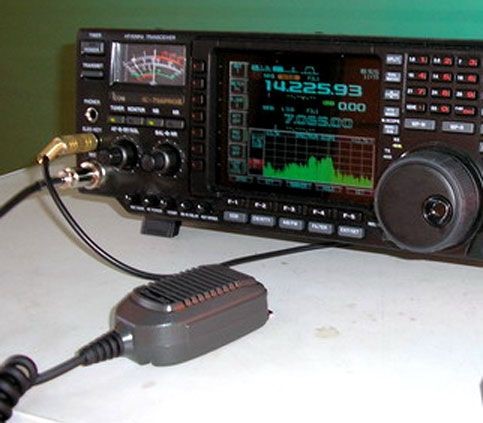Description

Disclaimer: Copyright infringement not intended.
Context
Advocating last mile connectivity and a HAM in every village, alongside the readiness of HAMs to aid in communication failures, a dedicated team of amateur radio operators (HAMs) embarked on a significant journey from the cyclone shelters of Nachugunta Island, Andhra Pradesh, to participate in the Island on the Air (IOTA) expedition.
Details
- Amateur Radio, often referred to as HAM Radio, is a popular hobby and service that allows licensed individuals to communicate with each other using designated radio frequencies for non-commercial purposes.
- It offers a wide range of activities, from local and international communication to emergency communications, experimentation, and technical innovation.
About Amateur Radio
- Definition: Amateur Radio refers to the use of radio frequency spectrum for personal, non-commercial purposes, such as recreation, experimentation, and emergency communication.
- Licensing: Amateur Radio operators, also known as "hams," must obtain an amateur radio license from their national regulatory authority. Licensing typically involves passing an examination covering radio theory, regulations, and operating practices.
- Call Signs: Licensed operators are assigned unique call signs, which they use to identify themselves when communicating on the airwaves.
Basic Concepts:
- Frequency Bands: Amateur Radio operates across a wide range of frequency bands allocated by international regulatory bodies such as the International Telecommunication Union (ITU). These bands range from very low frequency (VLF) to extremely high frequency (EHF).
- Modes of Communication: Hams use various modes of communication, including voice (SSB, FM, AM), Morse code (CW), digital modes (PSK31, FT8, RTTY), and image transmission (SSTV).
- Q Codes and Operating Procedures: Hams often use standardized Q codes and operating procedures to facilitate efficient communication and exchange of information.
Activities and Applications:
- DXing: DXing involves making long-distance contacts (DX) with stations located in distant countries or regions. DXing enthusiasts aim to contact as many different countries or entities as possible.
- Contesting: Contests are competitive events where hams compete to make the most contacts within a specified time frame or under specific conditions. Contests can range from local to international events.
- Satellite Communication: Hams use amateur radio satellites to communicate with each other from remote locations or while mobile. Satellite communication provides opportunities for experimentation and exploration.
- Public Service and Emergency Communication: Amateur Radio operators provide essential communication support during emergencies, natural disasters, and public service events. They work closely with emergency response agencies to establish communication links when other systems fail.

Equipment and Technology:
- Transceivers: Amateur Radio operators use transceivers, which are devices capable of both transmitting and receiving radio signals. Transceivers come in various configurations, including handheld, mobile, and base station units.
- Antennas: Antennas are crucial components of any Amateur Radio station, allowing operators to transmit and receive radio signals. There are numerous types of antennas, each optimized for specific frequency bands and operating conditions.
- Digital Modes and Software: Hams use specialized software and digital modes to encode, decode, and transmit data over radio frequencies. Digital modes offer efficient and reliable communication, especially under challenging conditions.
Benefits:
- Technical Learning and Skill Development: Amateur Radio offers opportunities for learning about electronics, radio theory, propagation, and antenna design. It provides hands-on experience in building, operating, and troubleshooting radio equipment.
- Community Engagement and Service: Hams play an active role in their communities by providing communication support during emergencies, participating in public service events, and promoting technological literacy.
- International Friendship and Collaboration: Amateur Radio fosters international friendships and collaboration, as operators communicate with fellow hams from around the world, exchange cultural information, and collaborate on technical projects.
Challenges:
- Propagation and Environmental Factors: Radio propagation conditions can vary significantly depending on factors such as frequency, time of day, weather, and geographic location. Hams must adapt to changing propagation conditions to maintain reliable communication.
- Regulatory Compliance: Amateur Radio operators must comply with local regulations and licensing requirements, which may impose restrictions on frequency usage, power output, and antenna installation.
- Technical and Operational Challenges: Building and maintaining a successful Amateur Radio station requires technical knowledge, equipment, and resources. Hams must continuously update their skills and adapt to advancements in technology and operating practices.
About Islands on the Air (IOTA)
- IOTA, or Islands On The Air, is a pioneering programme that connects radio amateurs worldwide with stations on islands.
- Established in 1964, it's managed by IOTA Ltd in collaboration with the Radio Society of Great Britain (RSGB), categorizing islands into groups for communication.

Conclusion
Amateur Radio is a dynamic and diverse hobby with a rich history and a vibrant global community. It offers enthusiasts the opportunity to explore the world of radio communication, develop technical skills, engage in public service, and foster international friendship and collaboration. As technology continues to evolve, Amateur Radio will remain a valuable and enduring pursuit for generations to come.
|
PRACTICE QUESTION
Q. As technology continues to evolve, Amateur Radio will remain a valuable and enduring pursuit for generations to come. Comment. (250 words)
|










